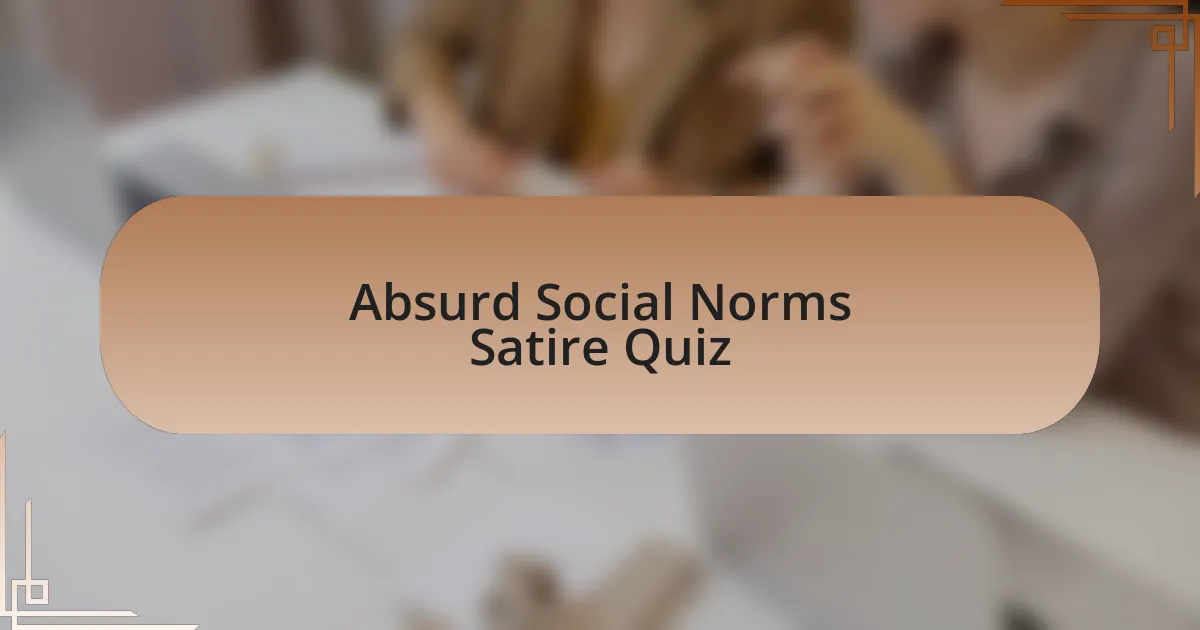Start of Absurd Social Norms Satire Quiz
1. What is the purpose of absurd social norms satire in humor?
- To critique societal norms and expose their absurdity.
- To ignore societal issues and focus only on personal stories.
- To entertain audiences without any deeper meaning.
- To promote traditional values and reinforce social expectations.
2. How can exaggeration be used effectively in satirical comedy?
- It makes situations less serious and more realistic.
- It solves the problems being satirized through rational arguments.
- It focuses solely on character development and dialogue.
- It highlights the absurdity of situations by taking them to extremes.
3. What social issue does `The Office` mock through its portrayal of corporate culture?
- The absurdity of corporate bureaucracy
- The silliness of sports competition
- The hilarity of home life
- The charm of small-town living
4. Which character in `Parks and Recreation` embodies absurd government bureaucracy?
- Tom Haverford
- Ron Swanson
- April Ludgate
- Leslie Knope
5. How does `Borat` utilize absurdity to comment on societal issues?
- `Borat` uses absurd situations to highlight cultural stereotypes and prejudices.
- `Borat` avoids controversial topics to entertain audiences.
- `Borat` presents serious discussions without humor or irony.
- `Borat` strictly follows realistic narratives with no exaggeration.
6. What is the role of irony in the humor of `Arrested Development`?
- It highlights the contradictions in characters` actions and beliefs.
- It favors clichés over innovative humor.
- It relies solely on physical comedy for laughs.
- It makes every joke a pun or play on words.
7. In what way does `Life of Brian` serve as a satire of organized religion?
- It depicts organized religion as a perfect institution without flaws.
- It highlights the absurdity of blind faith and religious zealotry.
- It suggests that all religious figures are infallible leaders.
- It promotes the idea of organized religion as a necessity for society.
8. What absurd social norm does `The Purge` satire through its exaggerated premise?
- The quirks of silly hats people wear
- The absurdity of extreme violence as a release valve
- The humor in everyday politeness standards
- The seriousness of workplace dress codes
9. How does `Black Mirror` critique technology`s impact on society through satire?
- `Black Mirror` uses dark humor to exaggerate technology`s potential harms.
- `Black Mirror` only focuses on traditional communication methods.
- `Black Mirror` promotes technology as entirely beneficial.
- `Black Mirror` avoids any critique of modern society.
10. Which absurd social norm is highlighted in `Curb Your Enthusiasm` through Larry David`s actions?
- Complimenting strangers
- Wearing socks with sandals
- Talking loudly in libraries
- Waiting in line for a bathroom
11. What facet of consumer culture does `Zoolander` satirize through its characters?
- Technology addiction
- Fashion obsession
- Gardening
- Cooking trends
12. How does `Mean Girls` present the absurdity of high school social hierarchies?
- It shows every character as genuinely supportive and kind.
- It depicts high school as a peaceful and harmonious environment.
- It exaggerates the social cliques and their quirks to show how ridiculous they are.
- It portrays students as serious and focused on academic achievement.
13. What is the comedic effect of the absurd societal expectations in `The Royal Tenenbaums`?
- It reinforces strict social norms.
- It highlights the ridiculousness of societal expectations.
- It promotes traditional values effortlessly.
- It completely ignores family dynamics.
14. Which satirical animated series presents exaggerated versions of American family life?
- Bob`s Burgers
- Family Guy
- The Simpsons
- Futurama
15. How does `Thank You for Smoking` critique the tobacco industry through absurdity?
- It uses extreme exaggeration of industry practices to showcase the ridiculousness of tobacco marketing.
- It presents a reality where everyone constantly praises smoking in absurd scenarios.
- It portrays tobacco executives as superheroes who save the world.
- It depicts smoking as a magical, life-enhancing experience without consequences.
16. In what way does `Fargo` use dark humor to criticize crime and morality?
- `Fargo` uses absurdity in crime plots to highlight moral failure.
- `Fargo` focuses on lighthearted moments to downplay crime actions.
- `Fargo` employs slapstick humor to divert from serious themes.
- `Fargo` relies on high-brow wit to discuss philosophical issues.
17. What absurd trend in dating does `How I Met Your Mother` satirize?
- The `two-minute rule`
- The `relationship contract`
- The `dating pyramid`
- The `slap bet`
18. How does `Freaks and Geeks` depict the absurdity of teenage social cliques?
- It suggests cliques are beneficial for personal growth.
- It highlights the ridiculousness of strict social hierarchies.
- It promotes the idea of fitting in at any cost.
- It ignores the pressures of teenage life entirely.
19. Which satirical film addresses the absurdity of fame and celebrity culture?
- `The Truman Show`
- `Step Brothers`
- `Wedding Crashers`
- `Ghostbusters`
20. How does `Friends` portray absurd relationships norms within its cast?
- It avoids humor to portray serious romantic themes.
- It promotes traditional marriage and family values.
- It absurdly exaggerates romantic interactions for humor.
- It strictly adheres to realistic relationship norms.
21. What is the function of irony in the humor of `30 Rock`?
- It makes all characters equally serious.
- It simplifies complex issues heavily.
- It highlights the absurdity of situations and characters.
- It only does slapstick jokes throughout.
22. How does `Superbad` satirize teenage experiences and coming-of-age expectations?
- It solely focuses on the success of popular students in high school.
- It hilariously exaggerates awkward social interactions and misunderstandings typical of teenage life.
- It glorifies the experiences of wealthy teenagers living in luxury.
- It portrays teenage life as devoid of any humor or ridiculous situations.
23. What societal trend does `The Hunger Games` absurdly exaggerate in its plot?
- Fitness culture
- Reality TV obsession
- Healthy eating habits
- Recycling trends
24. How does `Brooklyn Nine-Nine` utilize absurd workplace scenarios for humor?
- `Brooklyn Nine-Nine` uses characters in ludicrous situations for comedic effect.
- `Brooklyn Nine-Nine` relies solely on dramatic storylines for laughter.
- `Brooklyn Nine-Nine` features serious themes with no humor at all.
- `Brooklyn Nine-Nine` avoids absurdity and stays completely realistic.
25. Which element of social media behavior does `The Social Network` critique through satire?
- The importance of privacy
- The obsession with online validation
- The rise of traditional media
- The impact of censorship
26. How does `Community` showcase absurdities in higher education through its humor?
- `Community` avoids humor to focus on educational seriousness.
- `Community` features serious dramas about academic pressures.
- `Community` uses outrageous scenarios to critique academic pretentiousness.
- `Community` presents realistic portrayals of university life.
27. What absurd practice in politics is highlighted in the absurdity of `Veep`?
- Honest debates
- Symbolic gestures
- Thoughtful policies
- Political incompetence
28. How does `The Office` feature absurdity in workplace dynamics?
- It uses dramatized debates to highlight corporate values strictly.
- The show only features serious workplace discussions without humor.
- The humor is limited to slapstick jokes without any character development.
- The characters interact in bizarre and exaggerated ways, showcasing absurd situations.
29. Which social norm is satirized through the absurdity of the world in `WALL-E`?
- Individualism
- Isolationism
- Consumerism
- Environmentalism
30. How does `Kung Fu Hustle` use absurd martial arts tropes for comedic effect?
- `Kung Fu Hustle` presents martial arts in a serious and realistic manner.
- `Kung Fu Hustle` exaggerates martial arts clichés to create laugh-out-loud moments.
- `Kung Fu Hustle` avoids absurdity and sticks to traditional martial arts styles.
- `Kung Fu Hustle` focuses solely on dramatic fight sequences without humor.
Quiz Completed: Embracing the Absurdity!
Congratulations on completing the quiz on Absurd Social Norms Satire! We hope you not only had fun but also learned something valuable along the way. Humor often holds a mirror to society, making us question the norms we take for granted. Through answering the questions, you may have discovered how absurd some social conventions really are, highlighting the humor in our everyday lives.
Engaging with these quirky norms can deepen your appreciation for satire. It allows you to see the world from a different angle. You might even find yourself spotting absurdities in your own life that you previously overlooked. Identifying these moments can inspire laughter and provoke thought, creating a delightful blend of reflection and entertainment.
If you’re eager to dive deeper, we invite you to check out the next section on this page. There, you’ll find more insights on Absurd Social Norms Satire that can further expand your understanding. Embrace the humor in the ridiculous and allow it to enrich your perspective. Happy exploring!
Absurd Social Norms Satire
Understanding Absurd Social Norms in Humor
Absurd social norms are expectations or behaviors that seem illogical or nonsensical, yet are accepted by society. In humor, these norms become a tool for satire, allowing comedians to highlight the ridiculousness of societal expectations. Comedic commentary often exaggerates these norms to make a point, invoking laughter while inviting reflection. This form of humor exposes the contradictions in societal behavior, making audiences question the validity of such norms.
The Role of Satire in Critiquing Absurd Norms
Satire serves as a powerful mechanism to critique absurd social norms. It employs humor, irony, and exaggeration to highlight the flaws in societal behavior. Through various comedic formats, such as sketches or stand-up routines, satire encourages audiences to confront and reconsider their own acceptance of these norms. It effectively opens dialogues about what is deemed acceptable, ultimately sparking change or promoting awareness.
Common Examples of Absurd Social Norms in Comedy
Comedy often showcases absurd social norms through relatable scenarios. For instance, social conventions surrounding greetings can be mocked, such as the expectation to engage in small talk with strangers. Other examples include the pressure to conform to fashion trends that are impractical or the absurdity of corporate jargon in everyday conversation. These comedic depictions resonate with audiences, as they reveal the often irrational nature of daily interactions.
Cultural Variations in Absurd Social Norms
Cultural contexts shape perceptions of absurd social norms, influencing how humor is constructed. Different societies have unique absurdities, such as rigid dining etiquette or peculiar customs during holidays. Comedians often draw from these cultural nuances, crafting jokes that resonate with specific audiences while showcasing the absurdity inherent in their customs. This highlights the diversity of humor and demonstrates how social norms can be both amusing and perplexing across cultures.
The Impact of Technology on Absurd Social Norms in Humor
Technology significantly influences the portrayal of absurd social norms in humor. Social media platforms create new norms around communication—like the expectation of immediate responses or the pressure to curate an ideal online persona. Comedians leverage these developments, using satire to examine the absurdities of digital interactions. As technology evolves, the humor surrounding these changes often reflects societal anxieties, making the absurd more apparent in real-time.
What is Absurd Social Norms Satire?
Absurd Social Norms Satire is a comedic approach that critiques and highlights the irrationality of societal conventions. It uses exaggerated and nonsensical scenarios to showcase the absurdities in behavior, etiquette, or beliefs commonly accepted in everyday life. This technique prompts audiences to reflect on the often arbitrary nature of societal expectations. A historical example is the work of surrealist artists and writers in the early 20th century, who aimed to undermine conventional norms through absurdity.
How does Absurd Social Norms Satire function in humor?
This form of satire functions by presenting absurd scenarios that reveal the ridiculousness inherent in social norms. By subverting expectations, it creates humor through shock, surprise, or discomfort. Comedians like George Carlin and later shows like “The Office” utilize this technique to mock everyday behaviors and belief systems, encouraging audiences to question why they conform to these norms in the first place.
Where is Absurd Social Norms Satire commonly found?
Absurd Social Norms Satire is commonly found in various forms of media, including television, film, literature, and stand-up comedy. Programs such as “Saturday Night Live” and films like “Dr. Strangelove” exemplify this style. In literature, works by authors like Franz Kafka and David Foster Wallace explore absurdity in social constructs, using humor to challenge readers’ perspectives on normality.
When did Absurd Social Norms Satire become popular?
This form of satire became popular in the early to mid-20th century, particularly during the rise of surrealism and postmodernism. The absurdist movement in literature and theater flourished in the 1950s and 60s, with playwrights like Samuel Beckett making significant contributions. This period saw an acceleration in the questioning of traditional social norms through humor.
Who are notable figures in Absurd Social Norms Satire?
Notable figures in Absurd Social Norms Satire include playwrights like Samuel Beckett and Eugene Ionesco, as well as comedians like George Carlin and Louis C.K. Their works often blend absurdity with critical commentary on societal behaviors. Shows like “The Simpsons” also play a significant role in popularizing absurd satire by addressing and exaggerating everyday social norms.


